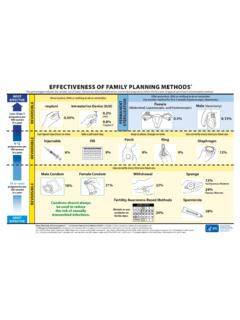Transcription of Racial, Ethnic, and Gender Disparities in Health Care in ...
1 April 2019. racial , ethnic , and Gender Disparities in Health care in medicare Advantage Office of Minority Health in collaboration with the RAND Corporation ii Contents Executive Summary ..iv Patient Experience Measures .. viii racial and ethnic Disparities in care : All Patient Experience racial and ethnic Disparities in care : All Clinical care Measures ..x Gender Disparities in care : All Patient Experience and Clinical care racial and ethnic Disparities in care by Gender : All Patient Experience Measures .. xii racial and ethnic Disparities in care by Gender : All Clinical care xiii 1. Section I: racial and ethnic Disparities in Health care in medicare Advantage .. 5. Disparities in care : All Patient Experience Measures.
2 6. Patient 8. Disparities in care : All Clinical care 15. Clinical care .. 18. Section II: Gender Disparities in Health care in medicare 51. Disparities in care : All Patient Experience and Clinical care 52. Patient 54. Clinical care .. 61. Section III: racial and ethnic Disparities by Gender in Health care in medicare 90. Disparities in care : All Patient Experience Measures .. 91. Patient 93. Disparities in care : All Clinical care 100. Clinical care .. 104. Appendix: Data Sources and Methods .. 135. References .. 137. iii Executive Summary racial , ethnic , and Gender Disparities in Health care in medicare Advantage This report describes quality of Health care received in 2017 by medicare beneficiaries enrolled in medicare Advantage (MA) plans nationwide ( percent of all medicare beneficiaries).
3 The report highlights racial and ethnic differences in Health care experiences and clinical care , compares quality of care for women and men, and looks at racial and ethnic differences in quality of care among women and men separately. The report is based on an analysis of two sources of information. The first source is the medicare Consumer Assessment of Healthcare Providers and Systems (CAHPS) Survey, which is conducted annually by the Centers for medicare & medicaid services (CMS) and focuses on experiences with the Health and drug plans ( , ease of getting needed care , how well providers communicate, and getting needed prescription drugs) of medicare beneficiaries across the nation.
4 The second source of information is the Healthcare Effectiveness Data and Information Set (HEDIS). HEDIS collects information from medical records and administrative data on the technical quality of care that medicare beneficiaries receive for a variety of medical issues, including diabetes, cardiovascular disease, and chronic lung disease. A comprehensive list of measures included in this report appears on p. viii. Scores on CAHPS measures are case-mix adjusted, as described in the appendix. HEDIS measures are not case- mix adjusted. Distribution of Race, Ethnicity, and Gender Among medicare Advantage Beneficiaries In 2017, an estimated percent of all MA beneficiaries were White, percent were Hispanic, percent were Black, percent were Asians or Pacific Islanders (API), percent were multiracial (not included in this report), and percent were American Indians or Alaska Natives (AI/AN), compared with percent, percent, percent, percent, percent, and percent, respectively, in the general medicare population.
5 An estimated percent of all medicare Advantage beneficiaries were female and percent were male, compared with percent and percent, respectively, in the general medicare population. racial and ethnic Disparities in Health care in medicare Advantage With just one exception, MA beneficiaries in racial and ethnic minority groups reported experiences with care that were either worse than or similar to the experiences reported by White beneficiaries (see figure on p. ix). Compared with White beneficiaries, AI/AN beneficiaries reported worse1 experiences on 1 measure and similar experiences on the other 6 measures. API beneficiaries reported worse experiences than Whites on 6 measures and better experiences on 1 measure.
6 Black beneficiaries reported worse experiences than Whites on 2 measures and similar experiences on the other 5. measures. Likewise, Hispanic beneficiaries reported worse experiences than Whites on 2 measures and similar experiences on the other 5 measures. racial and ethnic Disparities were more variable for the clinical care measures than for the patient experience measures (see figure on p. x). API beneficiaries received worse clinical care than Whites for 3. measures but received care of similar quality for 16 measures and better quality for 14 measures. Black beneficiaries received worse clinical care than Whites for 14 measures but received care of similar quality for 16 measures and better quality for 3 measures.
7 Hispanic beneficiaries received worse clinical 1. Here, worse and better are used to characterize differences that are statistically significant and exceed a magnitude threshold, as described in the appendix. Similar is used to characterize differences that are not statistically significant, fall below a magnitude threshold, or both. v care than White beneficiaries for 13 of 33 measures but received care of similar quality for 14 measures and better quality for 6 Gender Disparities in Health care in medicare Advantage In general, the quality of care received by women and men was similar. Women and men reported similar experiences with care for all measures of patient experience (see figure on p.)
8 Xi). Clinical care received by women and men was of similar quality for 23 of 29 For the 6 remaining measures, women received worse care than men for 4 measures and better care for 2 measures. racial and ethnic Disparities by Gender in Health care in medicare Advantage Patterns of racial and ethnic differences in patient experience among women and among men parallel the differences that were observed among both groups combined (see figure on p. xii). Among both women and men, API beneficiaries reported worse experiences than White beneficiaries with getting needed care , getting appointments and care quickly, customer service, doctor communication, care coordination, and getting needed patient drugs and had higher rates of vaccination for the flu.
9 Among both women and men, Black beneficiaries and Hispanic beneficiaries reported worse experiences than White beneficiaries with getting appointments and care quickly and had lower rates of vaccination for the flu. Otherwise, the experiences of Black beneficiaries and Hispanic beneficiaries were similar to those of Whites, regardless of Gender . Patterns of racial and ethnic differences in clinical care among women and men also parallel the differences observed among both groups combined (see figure on p. xiii). Among both women and men, API beneficiaries received worse clinical care than White beneficiaries for 4 of 31 measures; 3 of those 4. measures were the same for women and men.
10 API women received better care than White women for 9. measures, whereas API men received better care than White men for 10 measures; of those 9 or 10. measures, 8 were the same for women and men. Black women received worse clinical care than White women for 14 measures. Black men received worse clinical care than White men for those same 14. measures plus an additional 3 measures. Among both men and women, Black beneficiaries received better clinical care than White beneficiaries for 3 measures; 2 of those 3 measures were the same for women and men. Among both women and men, Hispanic beneficiaries received worse clinical care than White beneficiaries for 11 measures; 9 of those 11 measures were the same for women and men.














